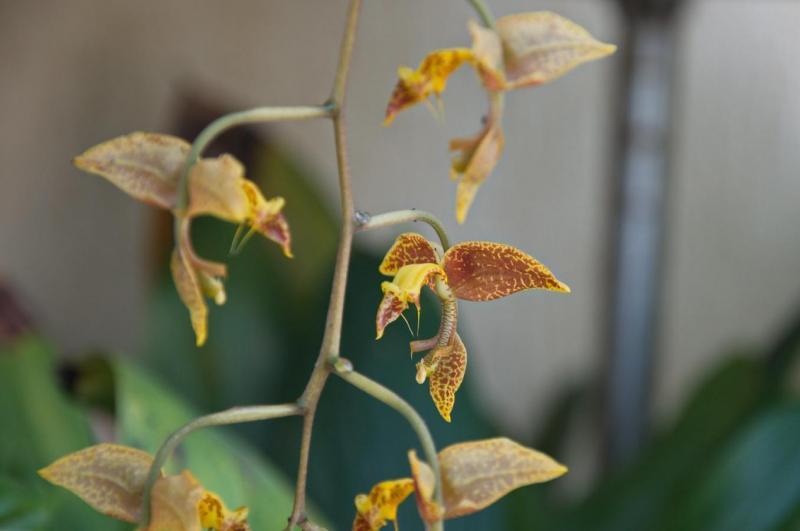Gongora portentosa
Also known as: The Bizarre Gongora or Gongora rosea Gongora portentosa var. rosea Gongora ecornuta in the subfamily: Epidendroideae
Native to: Bogota D.C. - Colombia Cundinamarca - Colombia Departamento del Cesar - Colombia Departamento del Huila - Colombia Junin - Peru Region de San Martin - Peru
General Information
The Bizarre Gongora is a sympodial cool to warm growing epiphytic orchid belonging to the sub family Epidendroideae native to Colombia and Peru.
Plant Description
Sympodial. Grows to 45-50cm. Each new growth has numerous elliptic lance shaped leaves that grow to 8-45cm long. Pseudobulbs grow to 6-8cm
Flowers
Numerous long lasting, fragrant blossoms appear during Autumn
Fragrance
The orchid is fragrant.
Blooming Season
- Autumn
Substrate(s)
- Coarse
- Spaghnum Moss
- Perlite
Care Notes
These orchids like to be kept on the dry side, but may need to be watered daily during warm weather, and prefer a well draining mix or also do well mounted, provided they can be watered regularly.
These are quite a forgiving orchid, there are no special requirements to get this orchid to flower, just good care and consistent conditions. Larger plants may be more fussy and can react poorly to change; a poorly timed repotting, a pest infection or an unusually hot day can set them back for a couple of years. However, even plants that have been treated poorly can thrive, and if they are set back they often recover much stronger then they would otherwise be.
Fragrant:- IsFragrant
Climate
Grows at high elevations. Rainfall ranges from 33mm to 109mm per day, heaviest in September and lightest in November. Temperature ranges from 15C to 27C, highest in March (17C to 27C) and lowest in January (15C to 26C).
Watering
These orchids are sensitive to excessive watering and should only be watered when they look thirsty. Water infrequently and ensure that the roots are dry before watering. Keep an eye on them especially during hot weather as overwatering can lead to rot, whereas underwatering may result in wilting or shriveling, which while unattractive, will not kill the plant.
Keep moisture levels up during hot weather as the plant is prone to dehydrationFertiliser
These plants thrive on fertiliser, especially during periods of growth. Liquid fertiliser can be applied year round at the recommended strength, augmented with manure pellets or other quickly degradable fertiliser, applied away from the base of the plant, during periods of strong growth. Slow release pellets can also be applied year round at the rate of 2-3 pellets per cup (250ml) of media.
They can benefit from a high phosphate fertiliser leading up to flowering season, and by a high nitrogen fertiliser when new growth appears.
Be sure to flush out excess fertiliser by running water through the media regularly year round. This plant is a heavy feeder year round, full strength fertiliser can be used. Fertiliser can be applied heavily year round. Use a high Nitrogen fertiliser year round. Use a low Nitrogen fertiliser during Summer and Winter. Use a high Phosphorous fertiliser during Summer and Winter. Reduce fertiliser when plant is dormant during Spring.Potting
Due to the growth nature of these plants they are best mounted onto cork, tree fern slabs, or even trees if the climate suits. Water regularly especially in hot weather.
Use water retentive media such as moss to prevent roots from drying out quickly This plant does very well in baskets or suspended pots This plant does well mounted to Cork slabs. Repotting is best done annually.








